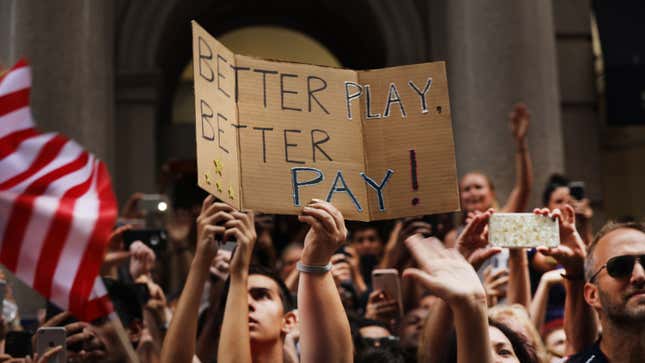Even after the World Cup wins, Olympic wins, the parades, and cries from the public for just pay, U.S. Soccer is legally supported in their refusal to pay women doing the same job as men a commensurate salary.
Judge Gary Klausner’s reasoning is deceptively simple. In the last year, the women’s team made more money than the men’s team, thus, according to his logic, there cannot be pay discrimination. But that’s where it gets complicated. The women’s team made that additional money from winning more games, allowing them to play more games, thus earning more prize pots from tournaments. (These prize pots are, of course, millions of dollars less than those earned winning a men’s tournament.) “During the class period, the [women’s national team] played 111 total games and made $24.5 million overall, averaging $220,747 per game,” Klausner wrote in his judgment. “By contrast, the [men’s national team] played 87 total games and made $18.5 million overall, averaging $212,639 per game.”
The men kept losing and thus got booted from tournaments, while the women went on to win their fourth World Cup–allowing them to play 23 more games than their male counterparts. So why did they have to do so much to make about eight thousand more dollars per game? They’ve got shit contracts.
As laid out by the Daily News, the women’s CBA focused on securing higher base salaries for players and other small “lady things” like child care, paid maternity leave, and medical insurance. The men’s team only worried about money during negotiations, because insurance and other benefits are guaranteed by Major League Soccer, which also guarantees millions of dollars regardless of whether a man is chosen for the national team. U.S. Soccer and the men’s national team included a pay-per-play bonus structure to award extra money for each game played by a member of the men’s team—and an additional bonus for tournament wins. The women, who already have lower salaries, only earn bonuses from prize money. Thus, it’s only because of the men’s team’s relatively poor performance that the women’s team outearned them.
U.S. Soccer claims that the women rejected a similar paid playing offer during their CBA negotiations. But Molly Levinson, a representative for the women’s team rejected the claim, telling Time last year that “in every instance for a friendly or competitive match, the women players were offered less pay than their male counterparts.” Megan Rapinoe reiterated Levinson’s statement during Good Morning America, “If we were under the men’s contract we’d be making three times more than we do now,” she said. “The men’s contract was never offered to us and certainly not the same amount of money.” Still, the team remains hopeful about its appeal and continued efforts for equal pay. Currently, the trial to argue the remaining issues in the case is set for June 16, having been pushed back due to the coronavirus.

